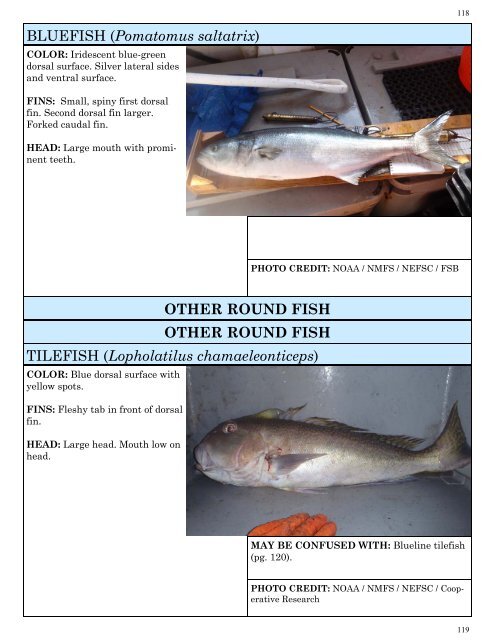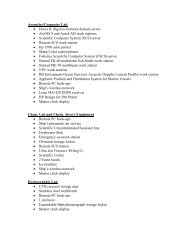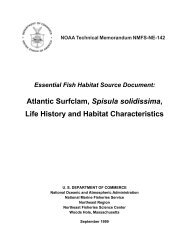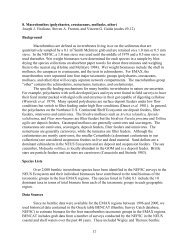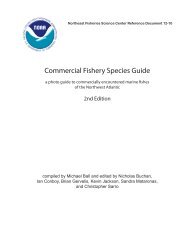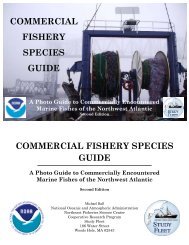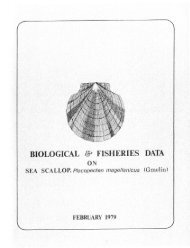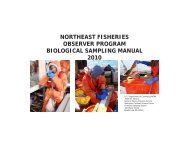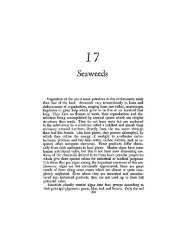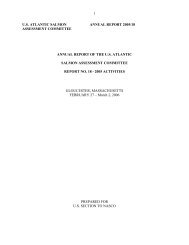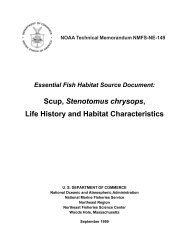BLUEFISH (Pomatomus saltatrix) OTHER ROUND FISH ... - NOAA
BLUEFISH (Pomatomus saltatrix) OTHER ROUND FISH ... - NOAA
BLUEFISH (Pomatomus saltatrix) OTHER ROUND FISH ... - NOAA
Create successful ePaper yourself
Turn your PDF publications into a flip-book with our unique Google optimized e-Paper software.
<strong>BLUE<strong>FISH</strong></strong> (<strong>Pomatomus</strong> <strong>saltatrix</strong>)<br />
COLOR: Iridescent blue-green<br />
dorsal surface. Silver lateral sides<br />
and ventral surface.<br />
FINS: Small, spiny first dorsal<br />
fin. Second dorsal fin larger.<br />
Forked caudal fin.<br />
HEAD: Large mouth with prominent<br />
teeth.<br />
<strong>OTHER</strong> <strong>ROUND</strong> <strong>FISH</strong><br />
TILE<strong>FISH</strong> (Lopholatilus chamaeleonticeps)<br />
COLOR: Blue dorsal surface with<br />
yellow spots.<br />
FINS: Fleshy tab in front of dorsal<br />
fin.<br />
HEAD: Large head. Mouth low on<br />
head.<br />
<strong>OTHER</strong> <strong>ROUND</strong> <strong>FISH</strong><br />
PHOTO CREDIT: <strong>NOAA</strong> / NMFS / NEFSC / FSB<br />
MAY BE CONFUSED WITH: Blueline tilefish<br />
(pg. 120).<br />
PHOTO CREDIT: <strong>NOAA</strong> / NMFS / NEFSC / Cooperative<br />
Research<br />
118<br />
118<br />
119<br />
119
BLUELINE TILE<strong>FISH</strong> (Caulolatilus microps)<br />
COLOR: Gray-blue. Narrow blue<br />
stripe from underside of eye to tip<br />
of snout.<br />
FINS: No fleshy tab in front of<br />
dorsal fin.<br />
BIGEYE (Priacanthus arenatus)<br />
COLOR: Red-orange.<br />
FINS: Rounded dorsal and anal<br />
fin.<br />
HEAD: Large eye.<br />
<strong>OTHER</strong> <strong>ROUND</strong> <strong>FISH</strong><br />
<strong>OTHER</strong> <strong>ROUND</strong> <strong>FISH</strong><br />
MAY BE CONFUSED WITH: Tilefish (pg.<br />
119).<br />
PHOTO CREDIT: <strong>NOAA</strong> / NMFS / NEFSC / Cooperative<br />
Research<br />
MAY BE CONFUSED WITH: Short bigeye<br />
(pg. 122).<br />
PHOTO CREDIT: MBL / Flescher Collection<br />
120<br />
120<br />
121<br />
121
SHORT BIGEYE (Pristigenys alta)<br />
COLOR: Red-orange. Pale caudal<br />
fin with black trailing edge. Black<br />
spots present on juveniles.<br />
BODY: Deep body.<br />
FINS: Spiny dorsal fin.<br />
HEAD: Large eye. Superior<br />
mouth.<br />
<strong>OTHER</strong> <strong>ROUND</strong> <strong>FISH</strong><br />
BARREL<strong>FISH</strong> (Hyperoglyphe perciformis)<br />
COLOR: Gray-brown.<br />
BODY: Deep body.<br />
HEAD: Blunt snout. No scales on<br />
top of head.<br />
<strong>OTHER</strong> <strong>ROUND</strong> <strong>FISH</strong><br />
MAY BE CONFUSED WITH: Bigeye (pg. 121).<br />
PHOTO CREDIT: <strong>NOAA</strong> / NMFS / NEFSC / Cooperative<br />
Research<br />
PHOTO CREDIT: University of Barcelona / José<br />
M. Blanco-Moreno.<br />
122<br />
122<br />
123<br />
123
BEARD<strong>FISH</strong> (Polymixia lowei)<br />
COLOR: Silver.<br />
FINS: Dorsal fin origin bisects<br />
body and extends towards caudal<br />
fin.<br />
HEAD: Two long barbels under<br />
chin. Blunt snout.<br />
<strong>OTHER</strong> <strong>ROUND</strong> <strong>FISH</strong><br />
PHOTO CREDIT: MBL / Flescher Collection<br />
NORTHERN PUFFER (Sphoeroides maculatus)<br />
COLOR: Olive-gray with many<br />
small dark spots. Vertical dark<br />
bars on lateral surface. White ventral<br />
surface.<br />
HEAD: Small mouth.<br />
DEFENSE MECHANISM: Inflates<br />
with water.<br />
<strong>OTHER</strong> <strong>ROUND</strong> <strong>FISH</strong><br />
PHOTO CREDIT: MBL / Flescher Collection<br />
124<br />
124<br />
125<br />
125
NORTHERN STARGAZER (Astroscopus guttatus)<br />
COLOR: Olive-brown dorsal surface<br />
with small white spots that<br />
become larger towards lateral surface.<br />
Horizontal bars on caudal fin<br />
extend onto body.<br />
HEAD: Superior mouth.<br />
COBIA (Rachycentron canadum)<br />
COLOR: Dark dorsal surface.<br />
Pale ventral surface. Two horizontal<br />
white stripes run to caudal fin<br />
on lateral surface; may fade with<br />
age.<br />
FINS: Anterior dorsal fin consisting<br />
of 8 spines that can fold into<br />
body.<br />
HEAD: Lower jaw protrudes past<br />
upper jaw; more prominent in<br />
adults.<br />
<strong>OTHER</strong> <strong>ROUND</strong> <strong>FISH</strong><br />
<strong>OTHER</strong> <strong>ROUND</strong> <strong>FISH</strong><br />
PHOTO CREDIT: <strong>NOAA</strong> / NMFS / NEFSC / Cooperative<br />
Research<br />
PHOTO CREDIT: <strong>NOAA</strong> / NMFS / SEFSC Pascagoula<br />
Laboratory; Collection of Brandi Noble<br />
126<br />
126<br />
127<br />
127
LIZARD<strong>FISH</strong> (Synodus sp.)<br />
COLOR: Green-brown. About 8<br />
diamond shaped marks on lateral<br />
surface.<br />
BODY: Body wider than it is tall.<br />
FINS: Anal fin base the same<br />
length or longer than dorsal fin<br />
base.<br />
HEAD: Pointed, triangular snout.<br />
<strong>OTHER</strong> <strong>ROUND</strong> <strong>FISH</strong><br />
REDEYE GAPER (Chaunax stigmaeus)<br />
COLOR: Red-orange blotched.<br />
BODY: Stitching pattern around<br />
head and on body.<br />
HEAD: Superior mouth.<br />
<strong>OTHER</strong> <strong>ROUND</strong> <strong>FISH</strong><br />
PHOTO CREDIT: UMASS / Dr. Joseph H. Kunkel<br />
PHOTO CREDIT: <strong>NOAA</strong> / NMFS / NEFSC / Cooperative<br />
Research<br />
128<br />
128<br />
129<br />
129
GOOSE<strong>FISH</strong> (MONK<strong>FISH</strong>) (Lophius gastrophysus)<br />
COLOR: Variable olive-brown<br />
dorsal surface with darker pectoral,<br />
dorsal, and caudal fins. White<br />
ventral surface.<br />
FINS: First dorsal fin spine located<br />
immediately posterior to<br />
mouth, and has small flap of skin<br />
at it’s tip (lure for prey).<br />
HEAD: Extremely large mouth<br />
with prominent teeth. Lower jaw<br />
projects significantly. Two large<br />
shoulder spines immediately posterior<br />
to head.<br />
<strong>OTHER</strong> <strong>ROUND</strong> <strong>FISH</strong><br />
NORTHERN SENNET (Sphyraena borealis)<br />
COLOR: Silver. Darker dorsal<br />
surface.<br />
FINS: Pelvic fins begin below origin<br />
of dorsal fin.<br />
HEAD: Lower jaw protrudes past<br />
upper jaw and has fleshy tip.<br />
<strong>OTHER</strong> <strong>ROUND</strong> <strong>FISH</strong><br />
PHOTO CREDIT: <strong>NOAA</strong> / NMFS / NEFSC / Cooperative<br />
Research<br />
PHOTO CREDIT: <strong>NOAA</strong> / NMFS / NEFSC / ESB<br />
130<br />
130<br />
131<br />
131
ATLANTIC SAURY (Scomberesox saurus)<br />
COLOR: Blue-green dorsal surface.<br />
Dark spot above pectoral fin.<br />
FINS: Row of finlets behind dorsal<br />
and anal fins.<br />
HEAD: Long, needle-like jaws.<br />
Upper and lower jaw are the same<br />
length.<br />
<strong>OTHER</strong> <strong>ROUND</strong> <strong>FISH</strong><br />
PHOTO CREDIT: <strong>NOAA</strong> / NMFS / NEFSC / ESB<br />
LONGSPINE SNIPE<strong>FISH</strong> (Macroramphosus scolopax)<br />
COLOR: Orange-red dorsal surface.<br />
Silver lateral surface.<br />
BODY: Laterally compressed.<br />
Body deepest at middle. Ventral<br />
surface slopes up from center towards<br />
head and caudal fin.<br />
HEAD: Long snout.<br />
SPINES: Dorsal spine as long as<br />
snout. When depressed, dorsal<br />
spine reaches middle of caudal fin.<br />
<strong>OTHER</strong> <strong>ROUND</strong> <strong>FISH</strong><br />
PHOTO CREDIT: <strong>NOAA</strong> / NMFS / NEFSC / Cooperative<br />
Research<br />
132<br />
132<br />
133<br />
133
ATLANTIC ARGENTINE (Argentina silus)<br />
COLOR: Silver. Adipose fin has<br />
yellow tint.<br />
BODY: Scales chafe easily in gear.<br />
FINS: Adipose fin present anterior<br />
to caudal fin.<br />
HEAD: Large eye.<br />
<strong>OTHER</strong> <strong>ROUND</strong> <strong>FISH</strong><br />
PHOTO CREDIT: <strong>NOAA</strong> / NMFS / NEFSC / Cooperative<br />
Research<br />
ALLIGATOR<strong>FISH</strong> (Aspidophoroides monopterygius)<br />
COLOR: Green-brown.<br />
BODY: Long body; smooth on top.<br />
Alligator-like scales.<br />
<strong>OTHER</strong> <strong>ROUND</strong> <strong>FISH</strong><br />
PHOTO CREDIT: <strong>NOAA</strong> / NMFS / NEFSC / Cooperative<br />
Research<br />
134<br />
134<br />
135<br />
135
LUMP<strong>FISH</strong> (Cyclopterus lumpus)<br />
COLOR: Blue-gray.<br />
BODY: Sucker on ventral surface.<br />
Rows of lumps on lateral surface,<br />
and on dorsal surface that run<br />
from head to caudal peduncle.<br />
<strong>OTHER</strong> <strong>ROUND</strong> <strong>FISH</strong><br />
GRENADIER (Family Macrouridae)<br />
COLOR: Blue-black.<br />
BODY: Body tapers to a point.<br />
FINS: First dorsal spine has serrated<br />
front edge.<br />
<strong>OTHER</strong> <strong>ROUND</strong> <strong>FISH</strong><br />
PHOTO CREDIT: UMASS / Dr. Joseph H. Kunkel<br />
PHOTO CREDIT: <strong>NOAA</strong> / NMFS / NEFSC / Cooperative<br />
Research<br />
136<br />
136<br />
137<br />
137


